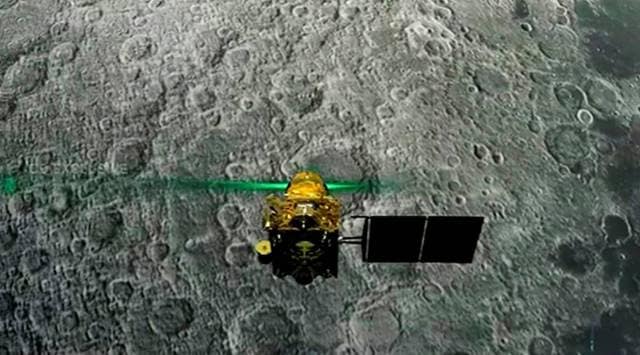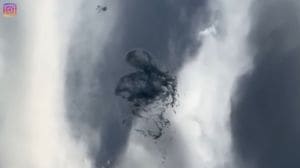- India
- International
ISRO: Chandrayaan-2 detects chromium, manganese through remote sensing
According to a statement from ISRO, the eight payloads onboard Chandrayaan-2 are conducting scientific observations of the Moon by remote sensing and in-situ techniques.
 The presence of the elements on the lunar surface was known so far through soil samples collected during earlier moon missions. (PTI)
The presence of the elements on the lunar surface was known so far through soil samples collected during earlier moon missions. (PTI)India’s Chandrayaan-2 spacecraft, which has completed more than 9,000 orbits around the Moon, has detected minor elements of chromium and managanese through remote sensing, officials of the Indian Space Research Organisation (ISRO) said on Monday.
At a two-day lunar science workshop livestreamed on Facebook and YouTube, marking the completion of two years of the second Moon mission launched on July 22, 2019, ISRO Chairman K Sivan said Chandrayaan-2 data is “national property” and implored the scientific and academia community to utilise the same for furthering science.
Sivan, who is also the secretary of Department of Space, released the science and data product documents from the mission output so far.
One of the sessions discussed payload results of Chandrayaan-2 Large Area Soft X-Ray Spectrometer (CLASS) measures the Moon’s X-ray Fluorescence (XRF) spectra to examine the presence of major elements such as magnesium, aluminium, silicon, calcium, titanium, iron, and sodium. Discussing the science results from it, principal investigator Shyama Narendranath, of CLASS payload stated that it has seen “definite detection of (minor elements) chromium and manganese for the first time (from the lunar surface through remote sensing), which was a surprise as these (elements) are less than one weight percentage on the moon”.
The two elements were detected at few places during intense solar flare events. The presence of the elements on the lunar surface was known so far through soil samples collected during earlier moon missions.

According to a statement from ISRO, the eight payloads onboard Chandrayaan-2 are conducting scientific observations of the Moon by remote sensing and in-situ techniques.
The first day of the workshop highlighted some of the distinguishing features of the payloads onboard the orbiter, an overview of the mission and scientific findings so far, payload operations, as well as detailed presentations on the science results from four of the eight payloads. Science results from the remaining four payloads are scheduled for discussion on Tuesday.
CLASS payload has also been able to remove ambiguities while detecting sodium in lunar surface. Although sodium was detected based on Chandrayaan-1 data, as published in a 2014 paper, the detection also held some uncertainties.
CLASS has also managed to obtain the first set of direct elemental abundances from all major elements “which makes up more than 99 per cent of all lunar surface”, according to Narendranath. Elements detected include oxygen, aluminium, silicon, calcium, titanium and iron.
Sivan released three documents — ‘Handbook of Chandrayaan 2 Payloads Data & Science’, ‘Science Results from Chandrayaan-2 Mission’ and ‘Chandrayaan-2 Orbiter Payloads and Data Products’.
While Chandrayaan-2 had failed its soft landing maneuver, thus losing the lander and rover and the associated five payloads, the orbiter with eight payloads onboard for mapping the lunar surface and outer atmosphere of the Moon, has successfully continued to send back data and is expected to be in operation for seven years after its launch.
Speaking from ISRO headquarters in Bengaluru, Sivan said that Chandrayan-2 can help us understand the evolution of the inner solar system as the Moon, being an airless celestial body, has preserved the signatures of the events that took place in the early years of the solar system.
“The results are very much encouraging… Students, faculty members, and scientists from colleges, universities and scientific institutes will be able to access and analyse the Chandrayaan-2 orbiter payloads’ data and add value to the mission. Participation of scientifically motivated minds from academia and institutes is highly solicited… (This) data is national property… and I want the entire scientific community across the country to make use of this data and discover new science which nobody else has done,” said Sivan.
Chairman of Apex Science Board and former ISRO chairman AS Kiran Kumar remarked that the satellite has been providing “excellent data” over the past two years. “Only when we start doing more and more intense data analysis, can we do justice to the mission of Chandrayaan-2…”
The Chandrayaan-2 Orbiter payloads’ data are available in the public domain through the host website pradan.issdc.gov.in and more data sets will be added as acquired by various payloads, over time.
Must Read
Buzzing Now
Apr 20: Latest News
- 01
- 02
- 03
- 04
- 05







































